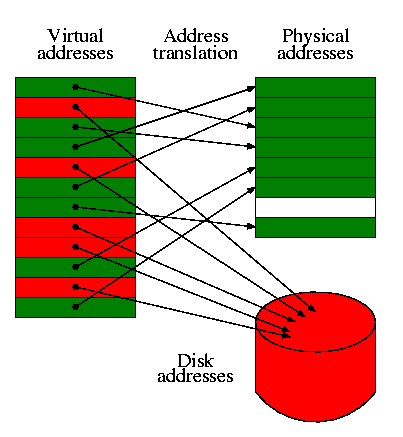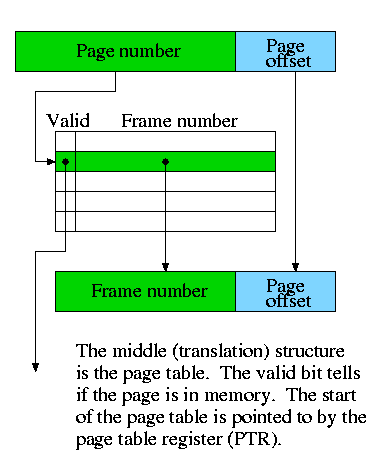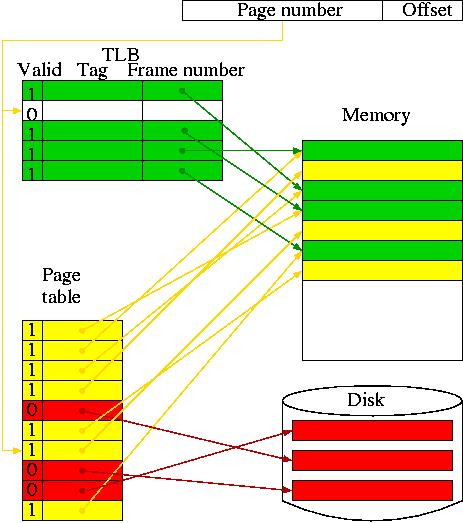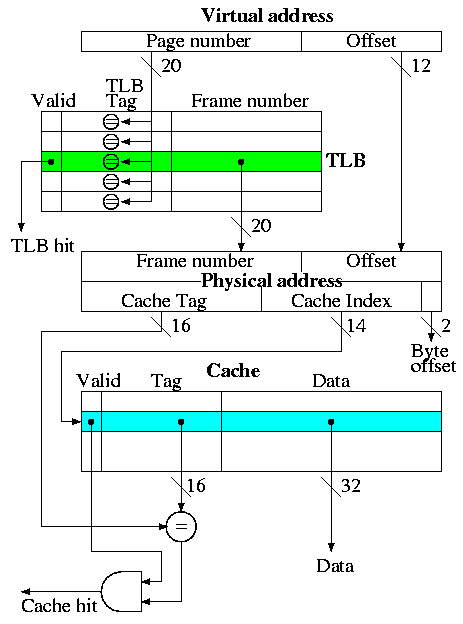http://cs.nyu.edu/~gottlieb/courses/2000s/2007-08-fall/arch/lectures/lecture-23.html
http://cs.nyu.edu/~gottlieb/courses/2000s/2007-08-fall/arch/lectures/

7.4: Virtual Memory
I realize this material was covered in operating systems class (V22.0202). I am just reviewing it here. The goal is to show the similarity to caching, which we just studied. Indeed, (the demand part of) demand paging is caching: In demand paging the memory serves as a cache for the disk, just as in caching the cache serves as a cache for the memory.
The names used are different and there are other differences as well.
| Cache concept | Demand paging analogue |
|---|---|
| Memory block | Page |
| Cache block | Page Frame (frame) |
| Blocksize | Pagesize |
| Tag | None (table lookup) |
| Word in block | Page offset |
| Valid bit | Valid bit |
| Miss | Page fault |
| Hit | Not a page fault |
| Miss rate | Page fault rate |
| Hit rate | 1 - Page fault rate |
| Cache concept | Demand paging analogue |
|---|---|
| Placement question | Placement question |
| Replacement question | Replacement question |
| Associativity | None (fully associative) |

- For both caching and demand paging, the placement question is trivial since the items are fixed size (no first-fit, best-fit, buddy, etc).
- The replacement question is not trivial. (P&H list this
under the placement question, which I believe is in error). Approximations to
LRU are popular for both caching and demand paging.
- The cost of a page fault vastly exceeds the cost of a cache miss so it is
worth while in paging to slow down hit processing to lower the miss rate. Hence
demand paging is fully associative and uses a table to locate the frame in which
the page is located.
- The figures to the right are for demand paging. But they can be interpreted
for caching as well.

- The (virtual) page number is the memory block number
- The Page offset is the word-in-block
- The frame (physical page) number is the cache block number (which is the index into the cache).
- Since demand paging uses full associativity, the tag is the entire memory block number. Instead of checking every cache block to see if the tags match, a (page) table is used.
Homework: 7.32
Write through vs. write back
Question: On a write hit should we write the new value through to (memory/disk) or just keep it in the (cache/memory) and write it back to (memory/disk) when the (cache-line/page) is replaced?
- Write through is simpler since write back requires two operations at a single event.
- But write-back has fewer writes to (memory/disk) since multiple writes to the (cache-line/page) may occur before the (cache-line/page) is evicted.
- For caching the cost of writing through to memory is probably less than 100 cycles so with a write buffer the cost of write through is bearable and it does simplify the situation.
- For paging the cost of writing through to disk is on the order of 1,000,000 cycles. Since write-back has fewer writes to disk, it is used.

Translation Lookaside Buffer (TLB)
A TLB is a cache of the page table
- Needed because otherwise every memory reference in the program would require
two memory references, one to read the page table and one to read the requested
memory word.
- Typical TLB parameter values
- Size: hundreds of entries.
- Block size: 1 entry.
- Hit time: 1 cycle.
- Miss time: tens of cycles.
- Miss rate: Low (<= 2%).
- In the diagram on the right:
- The green path is the fastest (TLB hit).
- The red is the slowest (page fault).
- The yellow is in the middle (TLB miss, no page fault).
- Really the page table doesn't point to the disk block for an invalid entry, but the effect is the same.

Putting it together: TLB + Cache
This is the decstation 3100
- Virtual address = 32 bits
- Physical address = 32 bits
- Fully associative TLB
- Direct mapped cache
- Cache blocksize = one word
- Pagesize = 4KB = 2^12 bytes
- Cache size = 16K entries = 64KB
Actions taken
- The page number is searched in the fully associative TLB
- If a TLB hit occurs, the frame number from the TLB together with the page offset gives the physical address. A TLB miss causes an exception to reload the TLB from the page table, which the figure does not show.
- The physical address is broken into a cache tag and cache index (plus a two bit byte offset that is not used for word references).
- If the reference is a write, just do it without checking for a cache hit (this is possible because the cache is so simple as we discussed previously).
- For a read, if the tag located in the cache entry specified by the index matches the tag in the physical address, the referenced word has been found in the cache; i.e., we had a read hit.
- For a read miss, the cache entry specified by the index is fetched from memory and the data returned to satisfy the request.
Hit/Miss possibilities
| TLB | Page | Cache | Remarks |
|---|---|---|---|
| hit | hit | hit | Possible, but page table not checked on TLB hit, data from cache |
| hit | hit | miss | Possible, but page table not checked, cache entry loaded from memory |
| hit | miss | hit | Impossible, TLB references in-memory pages |
| hit | miss | miss | Impossible, TLB references in-memory pages |
| miss | hit | hit | Possible, TLB entry loaded from page table, data from cache |
| miss | hit | miss | Possible, TLB entry loaded from page table, cache entry loaded from memory |
| miss | miss | hit | Impossible, cache is a subset of memory |
| miss | miss | miss | Possible, page fault brings in page, TLB entry loaded, cache loaded |
Homework: 7.31, 7.33
7.5: A Common Framework for Memory Hierarchies
Question 1: Where can/should the block be placed?
This question has three parts.
- In what slot are we able to place the block.
- For a direct mapped cache, there is only one choice.
- For an n-way associative cache, there are n choices.
- For a fully associative cache, any slot is permitted.
- The n-way case includes both the direct mapped and fully associative cases.
- For a TLB any slot is permitted. That is, a TLB is a fully associative cache of the page table.
- For paging any slot (i.e., frame) is permitted. That is, paging uses a fully associative mapping (via a page table).
- For segmentation, any large enough slot (i.e., region) can be used.
- If several possible slots are available, which one should be used?
- I call this question the placement question.
- For caches, TLBs and paging, which use fixed size slots, the question is trivial; any available slot is just fine.
- For segmentation, the question is interesting and there are several algorithms, e.g., first fit, best fit, buddy, etc.
- If no possible slots are available, which victim should be chosen?
- I call this question the replacement question.
- For direct mapped caches, the question is trivial. Since the block can only go in one slot, if you need to place the block and the only possible slot is not available, it must be the victim.
- For all the other cases, n-way associative caches (n>1), TLBs paging, and segmentation, the question is interesting and there are several algorithms, e.g., LRU, Random, Belady min, FIFO, etc.
- See question 3, below.
Question 2: How is a block found?
| Associativity | Location method | Comparisons Required |
|---|---|---|
| Direct mapped | Index | 1 |
| Set Associative | Index the set, search among elements | Degree of associativity |
| Full | Search all cache entries | Number of cache blocks |
| Separate lookup table | 0 |
Typical sizes and costs
| Feature | Typical values for caches |
Typical values for demand paging |
Typical values for TLBs |
|
| Size | 8KB-8MB | 128MB-8GB | 128B-4KB | |
| Block size | 32B-128B | 4KB-64KB | 4B-32B | |
| Miss penalty in clocks | 10-100 | 1M-10M | 10-100 | |
| Miss rate | .1%-10% | .000001%-.0001% | .01%-2% |
The difference in sizes and costs for demand paging vs. caching, leads to different algorithms for finding the block. Demand paging always uses the bottom row with a separate table (page table) but caching never uses such a table.
- With page faults so expensive, misses must be reduced as much as possible.
Hence full associativity is used.
- With such a large associativity (fully associative with many
slots), hardware would be prohibitively expensive and software searching too
slow. Hence a page table is used with a TLB acting as a cache.
- The large block size (called the page size) means that the extra table is a small fraction of the space.
Question 3: Which block should be replaced?
This is called the replacement question and is much studied in demand paging (remember back to 202).
- For demand paging, with miss costs so high and associativity so large, the
replacement policy is very important and some approximation to LRU is
used.
- For caching, even the miss time must be small so simple schemes are used. For 2-way associativity, LRU is trivial. For higher associativity (but associativity is never very high) crude approximations to LRU may be used and sometimes even random replacement is used.
Question 4: What happens on a write?
- Write-through
- Data written to both the cache and main memory (in general to both levels of the hierarchy).
- Sometimes used for caching, never used for demand paging.
- Advantages
- Misses are simpler and cheaper (no copy back).
- Easier to implement, especially for block size 1, which we did in class.
- For blocksize > 1, a write miss is more complicated since the rest of the block now is invalid. Fetch the rest of the block from memory (or mark those parts invalid by extra valid bits--not covered in this course).
Homework: 7.41
- Write-back
- Data only written to the cache. The memory has stale data, but becomes up to date when the cache block is subsequently replaced in the cache.
- Only real choice for demand paging since writing to the lower level of the memory hierarch (in this case disk) is so slow.
- Advantages
- Words can be written at cache speed not memory speed
- When blocksize > 1, writes to multiple words in the cache block are only written once to memory (when the block is replaced).
- Multiple writes to the same word in a short period are written to memory only once.
- When blocksize > 1, the replacement can utilize a high bandwidth transfer. That is, writing one 64-byte block is faster than 16 writes of 4-bytes each.
Write miss policy (advanced)
- For demand paging, the case is pretty clear. Every implementation I know of allocates frame for the page miss and fetches the page from disk. That is it does both an allocate and a fetch.
- For caching this is not always the case. Since there are two optional
actions there are four possibilities.
- Don't allocate and don't fetch: This is sometimes called write around. It is done when the data is not expected to be read before it will be evicted. For example, if you are writing a matrix whose size is much larger than the cache.
- Don't allocate but do fetch: Impossible, where would you put the fetched block?
- Do allocate, but don't fetch: Sometimes called no-fetch-on-write. Also called SANF (store-allocate-no-fetch). Requires multiple valid bits per block since the just-written word is valid but the others are not (since we updated the tag to correspond to the just-written word).
- Do allocate and do fetch: The normal case we have been using.